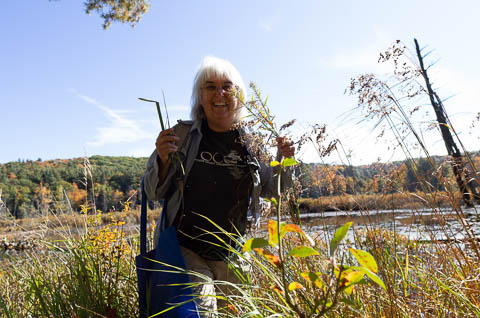Unique Flora and Fauna of the Bog
Plants of the Bog
The bog is replenished by rainwater that seeps in from the surrounding fields and one small stream, but the lack of a larger single source means that the pond isn't very rich in nutrients. Plants and animals who thrive in this environment must be adapted to finding nutrients in other ways. This is one of the reasons we find some species at Emmons Pond Bog that aren't found in other eastern woodland environments. The still water of the pond limits how much oxygen is in the water, which in turn limits the number of fish that can survive in this environment. Amphibians like frogs are far more common.
Sundews and Pitcher Plans have adapted to the low-nutrient conditions through carnivory--they eat small invertebrates like insects. Orchids give sugar to mycorrhizal fungi in exchange for nutrients that only the fungi can mine from rocks and soil. Shrubs like the Myrica Gale have root nodules that can fix nitrogen, providing another supplemental nutrient source.
There’s a few remnant trees on the bog mat that can grow just on the surface, but they will always be limited in size because their roots can grow spread only so far on the mat, and can't go very far down. From this vantage point you can see some larger dead trees in the water from the time before the most recent Beaver colony, when much of the current pond was actually dry forest.

Ferns, Deer, and a Changing Ecosystem
The many ferns you see at Emmons Pond provide a visible example of the competition between species and how ecosystems change over time. Ferns even tell us a story about human impacts on the environment.
The Hay-Scented Fern is native to the Northeast. Deer don't like the taste of it, and it can survive in deep shade, giving it free range over much of the understory. The fronds of the hay-scented fern all face in the same direction, towards the light, which is an easy-to-spot feature.
The Interrupted Fern is also native to this habitat. The fronds erupt from a common center but they're oriented willy-nilly, not all facing the same direction like the Hay-Scented Fern. Interrupted ferns tend to grow in clumps whereas Hay-Scented Ferns spread via rhizome and cover an area more densely.
As the deer population has exploded (in part because humans removed apex predators like wolves from the eastern woodlands), they've eaten more of the interrupted ferns, giving hay-scented ferns the advantage in the competition for the understory. Deer overpopulation have other impacts, including a long-term one: they've eaten a lot of the understory, including tree saplings that would otherwise replace the current mature trees in the forest. It's possible that left unmanaged, deer overpopulation may eventually lead to a thinning of the eastern woodlands as the mature trees die, fall, and are not replaced with saplings.
Species You Might Spot
Sundews
- Carnivorous, consume insects
- Covered in tendrils (look like red hairs) to lure in prey
- Red tendrils, green base
- Many types of sundews
Pitcher Plants
- Carnivorous, consume insects
- 8-24 inches tall
- Rose-shaped, tubular leaves around the base of the stalk
- Leaves up to 8 inches long
- Can vary in color from red to green to purple
- Leaves look like pitchers, often hold water
Myrica Gale
- Bushy shrub growing 2-4 feet high
- Dark green to gray leaves
- Long leaves smell sweet